Applying Structural Principles: Footing and Column Placement Report
VerifiedAdded on 2023/06/10
|13
|3394
|243
Report
AI Summary
This report analyzes the structural principles applied to the construction of a medium-sized factory complex, focusing on footing design, steel column placement, and temporary support systems. It details the use of pad and strip footings, describing their construction methods and sequences, including formworks, blinding sand layers, and the heights of piers and footings. The report outlines the construction sequence, from site clearing to backfilling, and identifies the plant and equipment used, such as cranes, excavators, and concrete mixers. It further explains the method for placing steel columns, emphasizing the use of starter bars, HD bolt cage templates, and grout to ensure precise verticality. The report also discusses the application of precast concrete panels and bracing as temporary support elements, highlighting their role in the construction process and illustrating precast connections. This comprehensive overview provides valuable insights into the practical aspects of structural engineering in building construction.
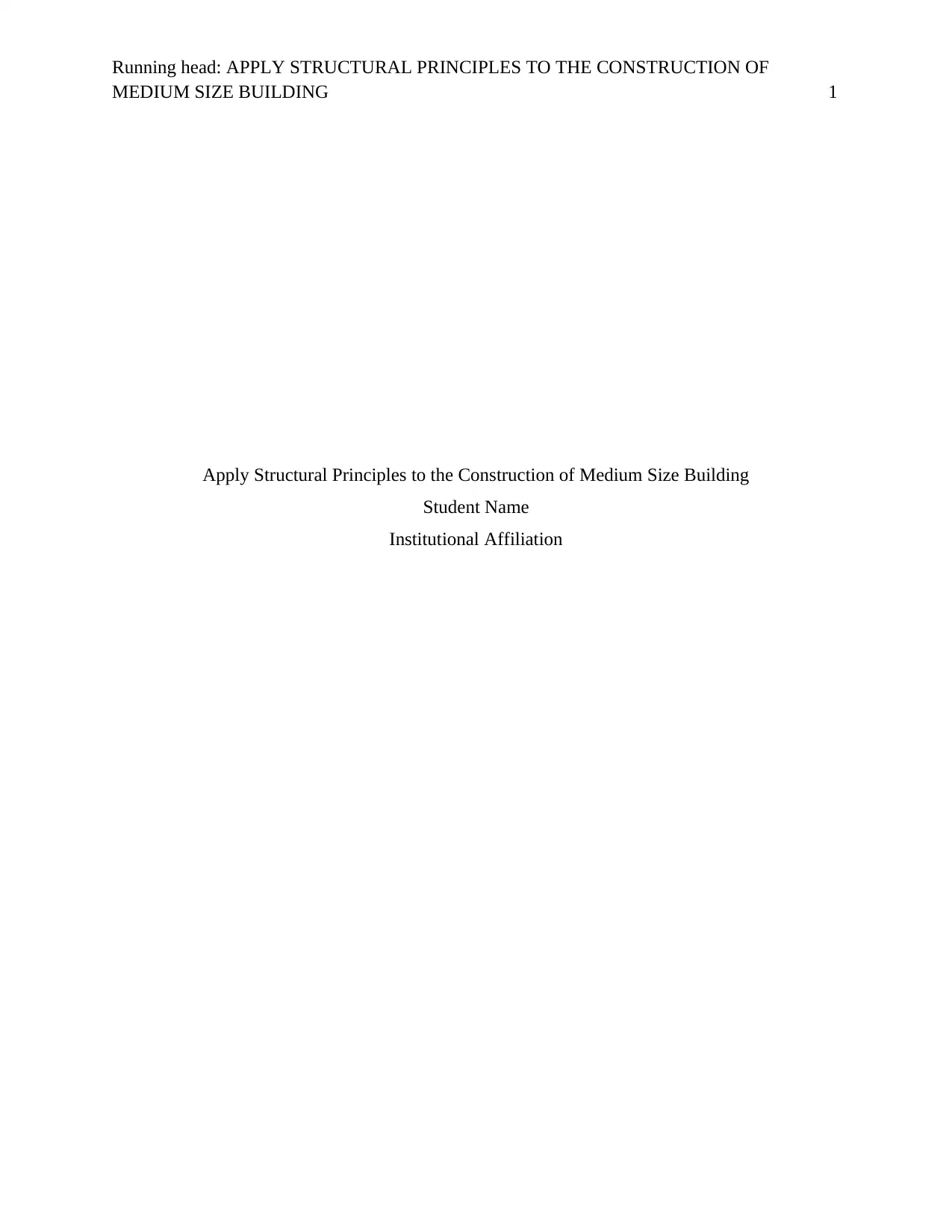
Running head: APPLY STRUCTURAL PRINCIPLES TO THE CONSTRUCTION OF
MEDIUM SIZE BUILDING 1
Apply Structural Principles to the Construction of Medium Size Building
Student Name
Institutional Affiliation
MEDIUM SIZE BUILDING 1
Apply Structural Principles to the Construction of Medium Size Building
Student Name
Institutional Affiliation
Paraphrase This Document
Need a fresh take? Get an instant paraphrase of this document with our AI Paraphraser
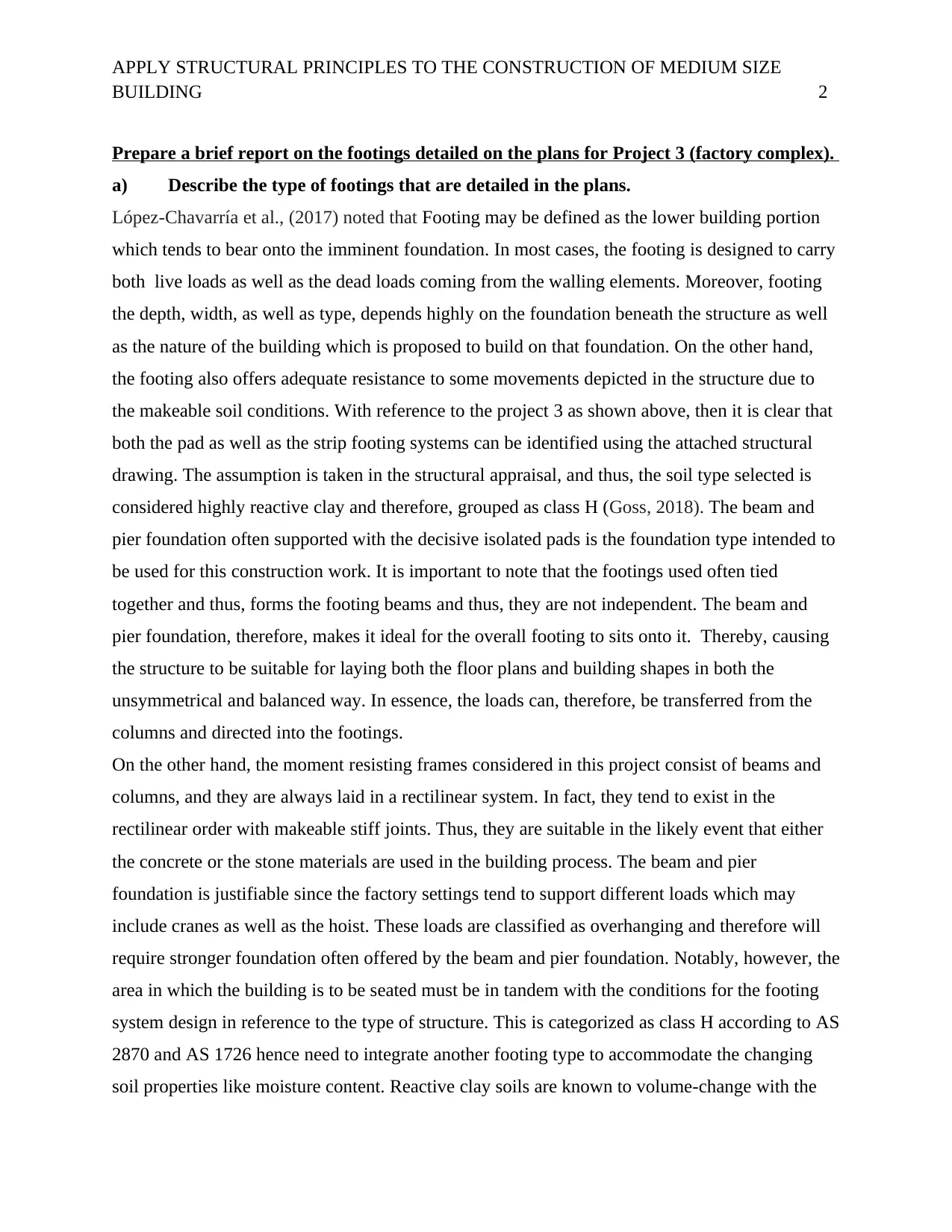
APPLY STRUCTURAL PRINCIPLES TO THE CONSTRUCTION OF MEDIUM SIZE
BUILDING 2
Prepare a brief report on the footings detailed on the plans for Project 3 (factory complex).
a) Describe the type of footings that are detailed in the plans.
López-Chavarría et al., (2017) noted that Footing may be defined as the lower building portion
which tends to bear onto the imminent foundation. In most cases, the footing is designed to carry
both live loads as well as the dead loads coming from the walling elements. Moreover, footing
the depth, width, as well as type, depends highly on the foundation beneath the structure as well
as the nature of the building which is proposed to build on that foundation. On the other hand,
the footing also offers adequate resistance to some movements depicted in the structure due to
the makeable soil conditions. With reference to the project 3 as shown above, then it is clear that
both the pad as well as the strip footing systems can be identified using the attached structural
drawing. The assumption is taken in the structural appraisal, and thus, the soil type selected is
considered highly reactive clay and therefore, grouped as class H (Goss, 2018). The beam and
pier foundation often supported with the decisive isolated pads is the foundation type intended to
be used for this construction work. It is important to note that the footings used often tied
together and thus, forms the footing beams and thus, they are not independent. The beam and
pier foundation, therefore, makes it ideal for the overall footing to sits onto it. Thereby, causing
the structure to be suitable for laying both the floor plans and building shapes in both the
unsymmetrical and balanced way. In essence, the loads can, therefore, be transferred from the
columns and directed into the footings.
On the other hand, the moment resisting frames considered in this project consist of beams and
columns, and they are always laid in a rectilinear system. In fact, they tend to exist in the
rectilinear order with makeable stiff joints. Thus, they are suitable in the likely event that either
the concrete or the stone materials are used in the building process. The beam and pier
foundation is justifiable since the factory settings tend to support different loads which may
include cranes as well as the hoist. These loads are classified as overhanging and therefore will
require stronger foundation often offered by the beam and pier foundation. Notably, however, the
area in which the building is to be seated must be in tandem with the conditions for the footing
system design in reference to the type of structure. This is categorized as class H according to AS
2870 and AS 1726 hence need to integrate another footing type to accommodate the changing
soil properties like moisture content. Reactive clay soils are known to volume-change with the
BUILDING 2
Prepare a brief report on the footings detailed on the plans for Project 3 (factory complex).
a) Describe the type of footings that are detailed in the plans.
López-Chavarría et al., (2017) noted that Footing may be defined as the lower building portion
which tends to bear onto the imminent foundation. In most cases, the footing is designed to carry
both live loads as well as the dead loads coming from the walling elements. Moreover, footing
the depth, width, as well as type, depends highly on the foundation beneath the structure as well
as the nature of the building which is proposed to build on that foundation. On the other hand,
the footing also offers adequate resistance to some movements depicted in the structure due to
the makeable soil conditions. With reference to the project 3 as shown above, then it is clear that
both the pad as well as the strip footing systems can be identified using the attached structural
drawing. The assumption is taken in the structural appraisal, and thus, the soil type selected is
considered highly reactive clay and therefore, grouped as class H (Goss, 2018). The beam and
pier foundation often supported with the decisive isolated pads is the foundation type intended to
be used for this construction work. It is important to note that the footings used often tied
together and thus, forms the footing beams and thus, they are not independent. The beam and
pier foundation, therefore, makes it ideal for the overall footing to sits onto it. Thereby, causing
the structure to be suitable for laying both the floor plans and building shapes in both the
unsymmetrical and balanced way. In essence, the loads can, therefore, be transferred from the
columns and directed into the footings.
On the other hand, the moment resisting frames considered in this project consist of beams and
columns, and they are always laid in a rectilinear system. In fact, they tend to exist in the
rectilinear order with makeable stiff joints. Thus, they are suitable in the likely event that either
the concrete or the stone materials are used in the building process. The beam and pier
foundation is justifiable since the factory settings tend to support different loads which may
include cranes as well as the hoist. These loads are classified as overhanging and therefore will
require stronger foundation often offered by the beam and pier foundation. Notably, however, the
area in which the building is to be seated must be in tandem with the conditions for the footing
system design in reference to the type of structure. This is categorized as class H according to AS
2870 and AS 1726 hence need to integrate another footing type to accommodate the changing
soil properties like moisture content. Reactive clay soils are known to volume-change with the
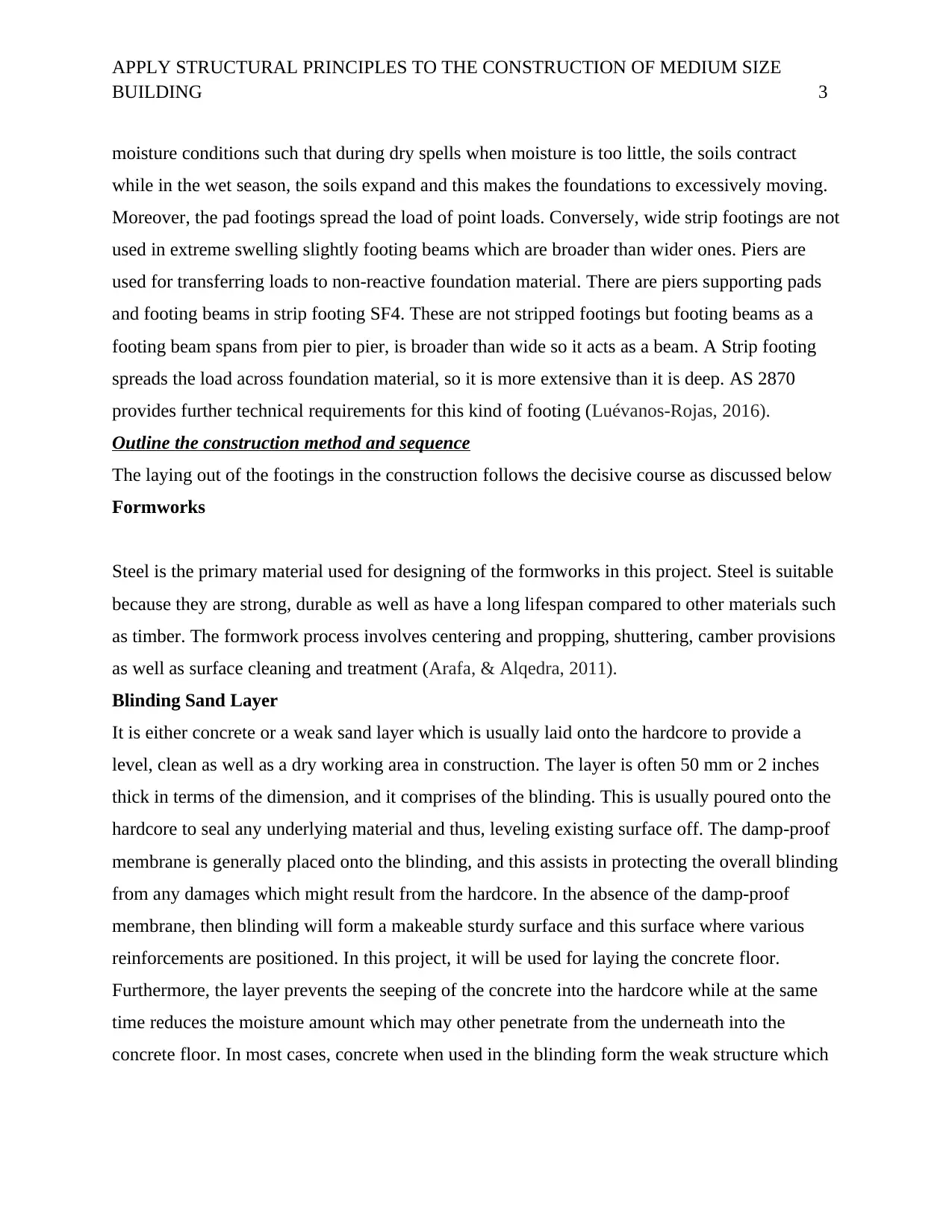
APPLY STRUCTURAL PRINCIPLES TO THE CONSTRUCTION OF MEDIUM SIZE
BUILDING 3
moisture conditions such that during dry spells when moisture is too little, the soils contract
while in the wet season, the soils expand and this makes the foundations to excessively moving.
Moreover, the pad footings spread the load of point loads. Conversely, wide strip footings are not
used in extreme swelling slightly footing beams which are broader than wider ones. Piers are
used for transferring loads to non-reactive foundation material. There are piers supporting pads
and footing beams in strip footing SF4. These are not stripped footings but footing beams as a
footing beam spans from pier to pier, is broader than wide so it acts as a beam. A Strip footing
spreads the load across foundation material, so it is more extensive than it is deep. AS 2870
provides further technical requirements for this kind of footing (Luévanos-Rojas, 2016).
Outline the construction method and sequence
The laying out of the footings in the construction follows the decisive course as discussed below
Formworks
Steel is the primary material used for designing of the formworks in this project. Steel is suitable
because they are strong, durable as well as have a long lifespan compared to other materials such
as timber. The formwork process involves centering and propping, shuttering, camber provisions
as well as surface cleaning and treatment (Arafa, & Alqedra, 2011).
Blinding Sand Layer
It is either concrete or a weak sand layer which is usually laid onto the hardcore to provide a
level, clean as well as a dry working area in construction. The layer is often 50 mm or 2 inches
thick in terms of the dimension, and it comprises of the blinding. This is usually poured onto the
hardcore to seal any underlying material and thus, leveling existing surface off. The damp-proof
membrane is generally placed onto the blinding, and this assists in protecting the overall blinding
from any damages which might result from the hardcore. In the absence of the damp-proof
membrane, then blinding will form a makeable sturdy surface and this surface where various
reinforcements are positioned. In this project, it will be used for laying the concrete floor.
Furthermore, the layer prevents the seeping of the concrete into the hardcore while at the same
time reduces the moisture amount which may other penetrate from the underneath into the
concrete floor. In most cases, concrete when used in the blinding form the weak structure which
BUILDING 3
moisture conditions such that during dry spells when moisture is too little, the soils contract
while in the wet season, the soils expand and this makes the foundations to excessively moving.
Moreover, the pad footings spread the load of point loads. Conversely, wide strip footings are not
used in extreme swelling slightly footing beams which are broader than wider ones. Piers are
used for transferring loads to non-reactive foundation material. There are piers supporting pads
and footing beams in strip footing SF4. These are not stripped footings but footing beams as a
footing beam spans from pier to pier, is broader than wide so it acts as a beam. A Strip footing
spreads the load across foundation material, so it is more extensive than it is deep. AS 2870
provides further technical requirements for this kind of footing (Luévanos-Rojas, 2016).
Outline the construction method and sequence
The laying out of the footings in the construction follows the decisive course as discussed below
Formworks
Steel is the primary material used for designing of the formworks in this project. Steel is suitable
because they are strong, durable as well as have a long lifespan compared to other materials such
as timber. The formwork process involves centering and propping, shuttering, camber provisions
as well as surface cleaning and treatment (Arafa, & Alqedra, 2011).
Blinding Sand Layer
It is either concrete or a weak sand layer which is usually laid onto the hardcore to provide a
level, clean as well as a dry working area in construction. The layer is often 50 mm or 2 inches
thick in terms of the dimension, and it comprises of the blinding. This is usually poured onto the
hardcore to seal any underlying material and thus, leveling existing surface off. The damp-proof
membrane is generally placed onto the blinding, and this assists in protecting the overall blinding
from any damages which might result from the hardcore. In the absence of the damp-proof
membrane, then blinding will form a makeable sturdy surface and this surface where various
reinforcements are positioned. In this project, it will be used for laying the concrete floor.
Furthermore, the layer prevents the seeping of the concrete into the hardcore while at the same
time reduces the moisture amount which may other penetrate from the underneath into the
concrete floor. In most cases, concrete when used in the blinding form the weak structure which
⊘ This is a preview!⊘
Do you want full access?
Subscribe today to unlock all pages.

Trusted by 1+ million students worldwide
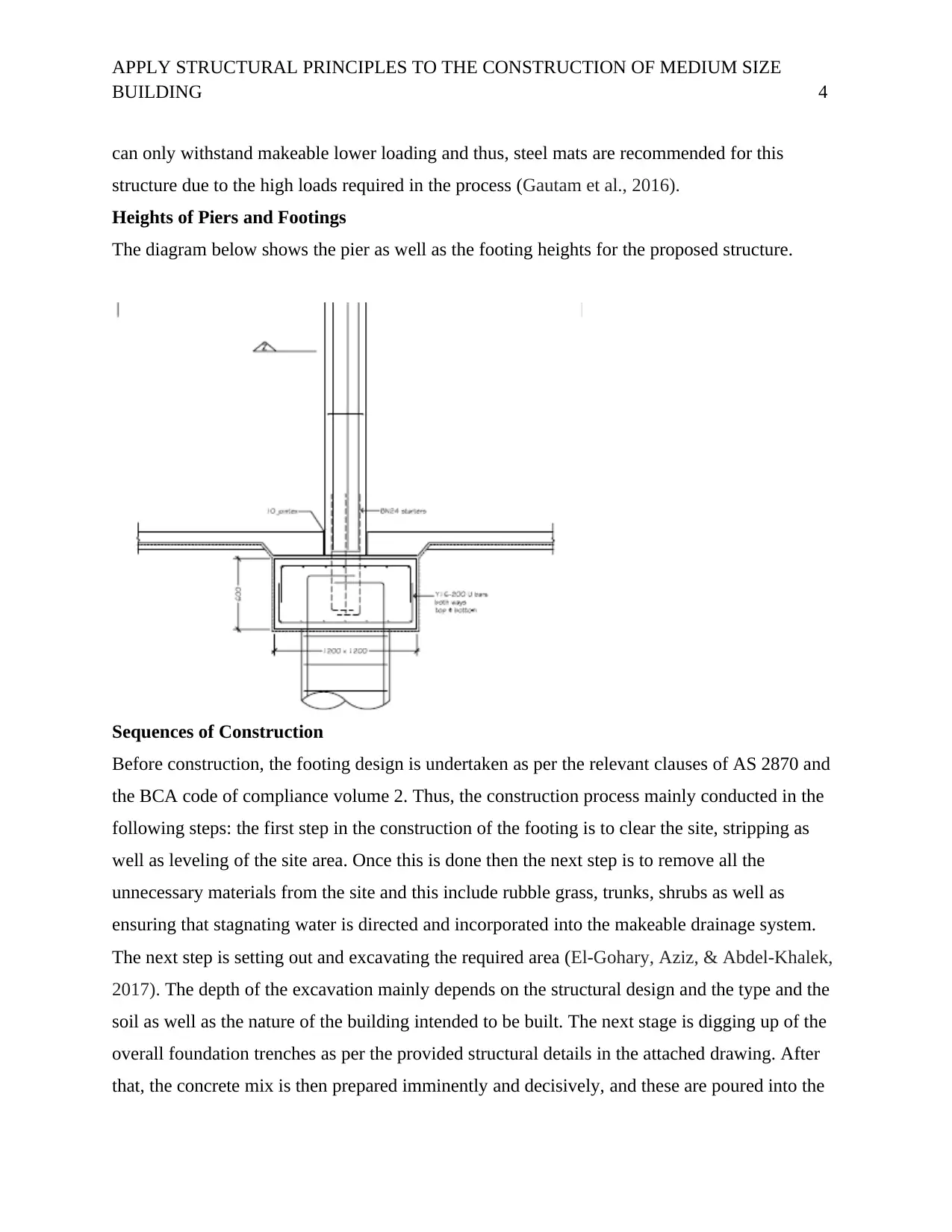
APPLY STRUCTURAL PRINCIPLES TO THE CONSTRUCTION OF MEDIUM SIZE
BUILDING 4
can only withstand makeable lower loading and thus, steel mats are recommended for this
structure due to the high loads required in the process (Gautam et al., 2016).
Heights of Piers and Footings
The diagram below shows the pier as well as the footing heights for the proposed structure.
Sequences of Construction
Before construction, the footing design is undertaken as per the relevant clauses of AS 2870 and
the BCA code of compliance volume 2. Thus, the construction process mainly conducted in the
following steps: the first step in the construction of the footing is to clear the site, stripping as
well as leveling of the site area. Once this is done then the next step is to remove all the
unnecessary materials from the site and this include rubble grass, trunks, shrubs as well as
ensuring that stagnating water is directed and incorporated into the makeable drainage system.
The next step is setting out and excavating the required area (El-Gohary, Aziz, & Abdel-Khalek,
2017). The depth of the excavation mainly depends on the structural design and the type and the
soil as well as the nature of the building intended to be built. The next stage is digging up of the
overall foundation trenches as per the provided structural details in the attached drawing. After
that, the concrete mix is then prepared imminently and decisively, and these are poured into the
BUILDING 4
can only withstand makeable lower loading and thus, steel mats are recommended for this
structure due to the high loads required in the process (Gautam et al., 2016).
Heights of Piers and Footings
The diagram below shows the pier as well as the footing heights for the proposed structure.
Sequences of Construction
Before construction, the footing design is undertaken as per the relevant clauses of AS 2870 and
the BCA code of compliance volume 2. Thus, the construction process mainly conducted in the
following steps: the first step in the construction of the footing is to clear the site, stripping as
well as leveling of the site area. Once this is done then the next step is to remove all the
unnecessary materials from the site and this include rubble grass, trunks, shrubs as well as
ensuring that stagnating water is directed and incorporated into the makeable drainage system.
The next step is setting out and excavating the required area (El-Gohary, Aziz, & Abdel-Khalek,
2017). The depth of the excavation mainly depends on the structural design and the type and the
soil as well as the nature of the building intended to be built. The next stage is digging up of the
overall foundation trenches as per the provided structural details in the attached drawing. After
that, the concrete mix is then prepared imminently and decisively, and these are poured into the
Paraphrase This Document
Need a fresh take? Get an instant paraphrase of this document with our AI Paraphraser
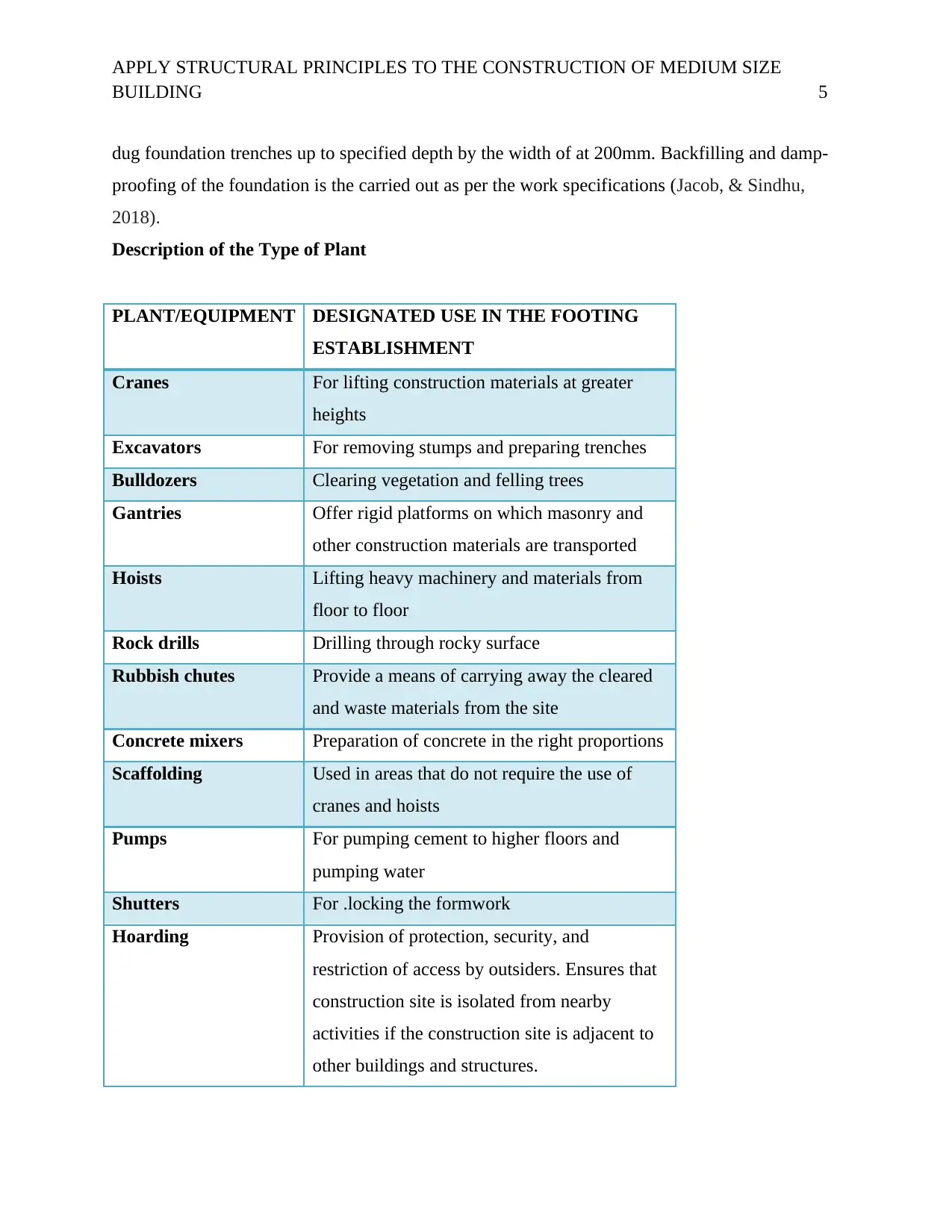
APPLY STRUCTURAL PRINCIPLES TO THE CONSTRUCTION OF MEDIUM SIZE
BUILDING 5
dug foundation trenches up to specified depth by the width of at 200mm. Backfilling and damp-
proofing of the foundation is the carried out as per the work specifications (Jacob, & Sindhu,
2018).
Description of the Type of Plant
PLANT/EQUIPMENT DESIGNATED USE IN THE FOOTING
ESTABLISHMENT
Cranes For lifting construction materials at greater
heights
Excavators For removing stumps and preparing trenches
Bulldozers Clearing vegetation and felling trees
Gantries Offer rigid platforms on which masonry and
other construction materials are transported
Hoists Lifting heavy machinery and materials from
floor to floor
Rock drills Drilling through rocky surface
Rubbish chutes Provide a means of carrying away the cleared
and waste materials from the site
Concrete mixers Preparation of concrete in the right proportions
Scaffolding Used in areas that do not require the use of
cranes and hoists
Pumps For pumping cement to higher floors and
pumping water
Shutters For .locking the formwork
Hoarding Provision of protection, security, and
restriction of access by outsiders. Ensures that
construction site is isolated from nearby
activities if the construction site is adjacent to
other buildings and structures.
BUILDING 5
dug foundation trenches up to specified depth by the width of at 200mm. Backfilling and damp-
proofing of the foundation is the carried out as per the work specifications (Jacob, & Sindhu,
2018).
Description of the Type of Plant
PLANT/EQUIPMENT DESIGNATED USE IN THE FOOTING
ESTABLISHMENT
Cranes For lifting construction materials at greater
heights
Excavators For removing stumps and preparing trenches
Bulldozers Clearing vegetation and felling trees
Gantries Offer rigid platforms on which masonry and
other construction materials are transported
Hoists Lifting heavy machinery and materials from
floor to floor
Rock drills Drilling through rocky surface
Rubbish chutes Provide a means of carrying away the cleared
and waste materials from the site
Concrete mixers Preparation of concrete in the right proportions
Scaffolding Used in areas that do not require the use of
cranes and hoists
Pumps For pumping cement to higher floors and
pumping water
Shutters For .locking the formwork
Hoarding Provision of protection, security, and
restriction of access by outsiders. Ensures that
construction site is isolated from nearby
activities if the construction site is adjacent to
other buildings and structures.
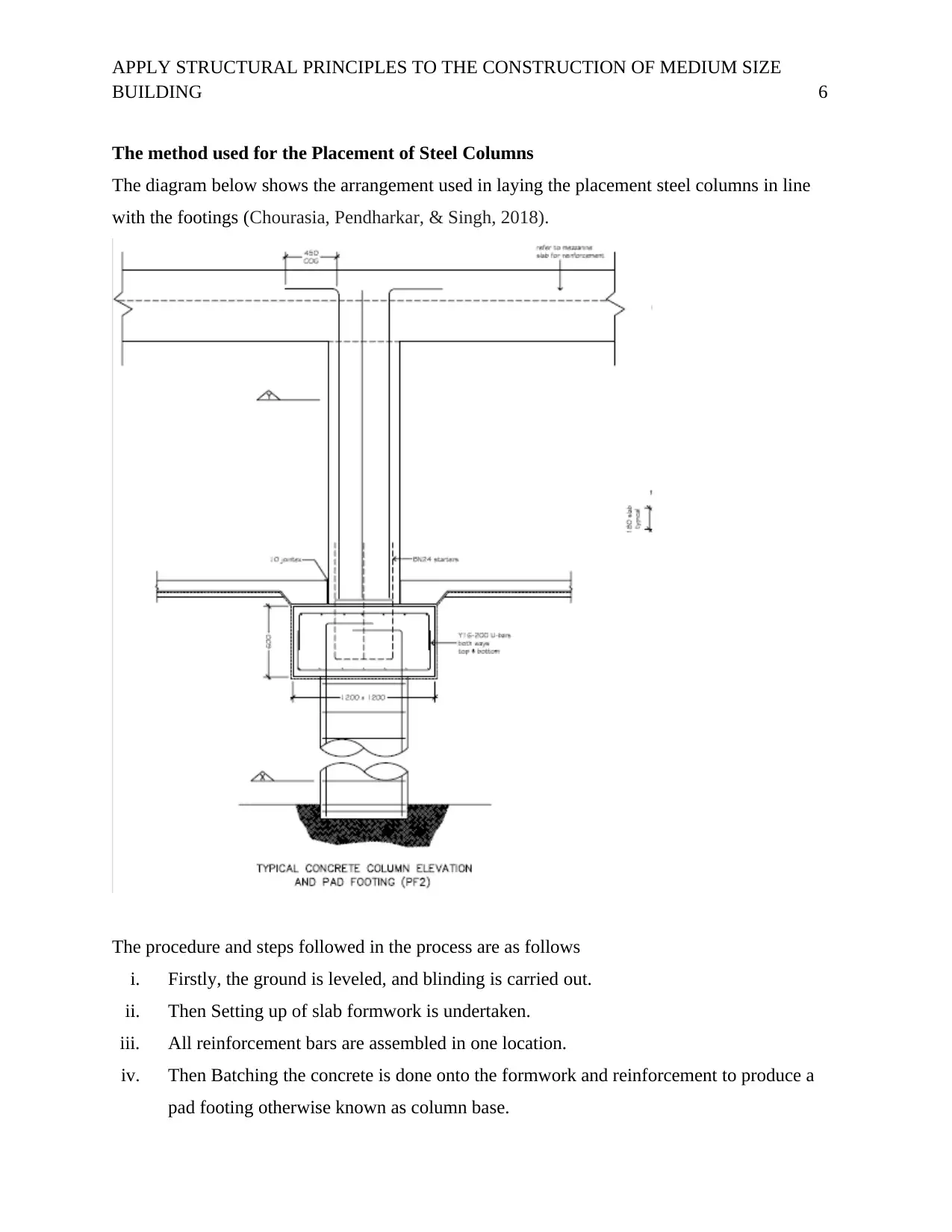
APPLY STRUCTURAL PRINCIPLES TO THE CONSTRUCTION OF MEDIUM SIZE
BUILDING 6
The method used for the Placement of Steel Columns
The diagram below shows the arrangement used in laying the placement steel columns in line
with the footings (Chourasia, Pendharkar, & Singh, 2018).
The procedure and steps followed in the process are as follows
i. Firstly, the ground is leveled, and blinding is carried out.
ii. Then Setting up of slab formwork is undertaken.
iii. All reinforcement bars are assembled in one location.
iv. Then Batching the concrete is done onto the formwork and reinforcement to produce a
pad footing otherwise known as column base.
BUILDING 6
The method used for the Placement of Steel Columns
The diagram below shows the arrangement used in laying the placement steel columns in line
with the footings (Chourasia, Pendharkar, & Singh, 2018).
The procedure and steps followed in the process are as follows
i. Firstly, the ground is leveled, and blinding is carried out.
ii. Then Setting up of slab formwork is undertaken.
iii. All reinforcement bars are assembled in one location.
iv. Then Batching the concrete is done onto the formwork and reinforcement to produce a
pad footing otherwise known as column base.
⊘ This is a preview!⊘
Do you want full access?
Subscribe today to unlock all pages.

Trusted by 1+ million students worldwide
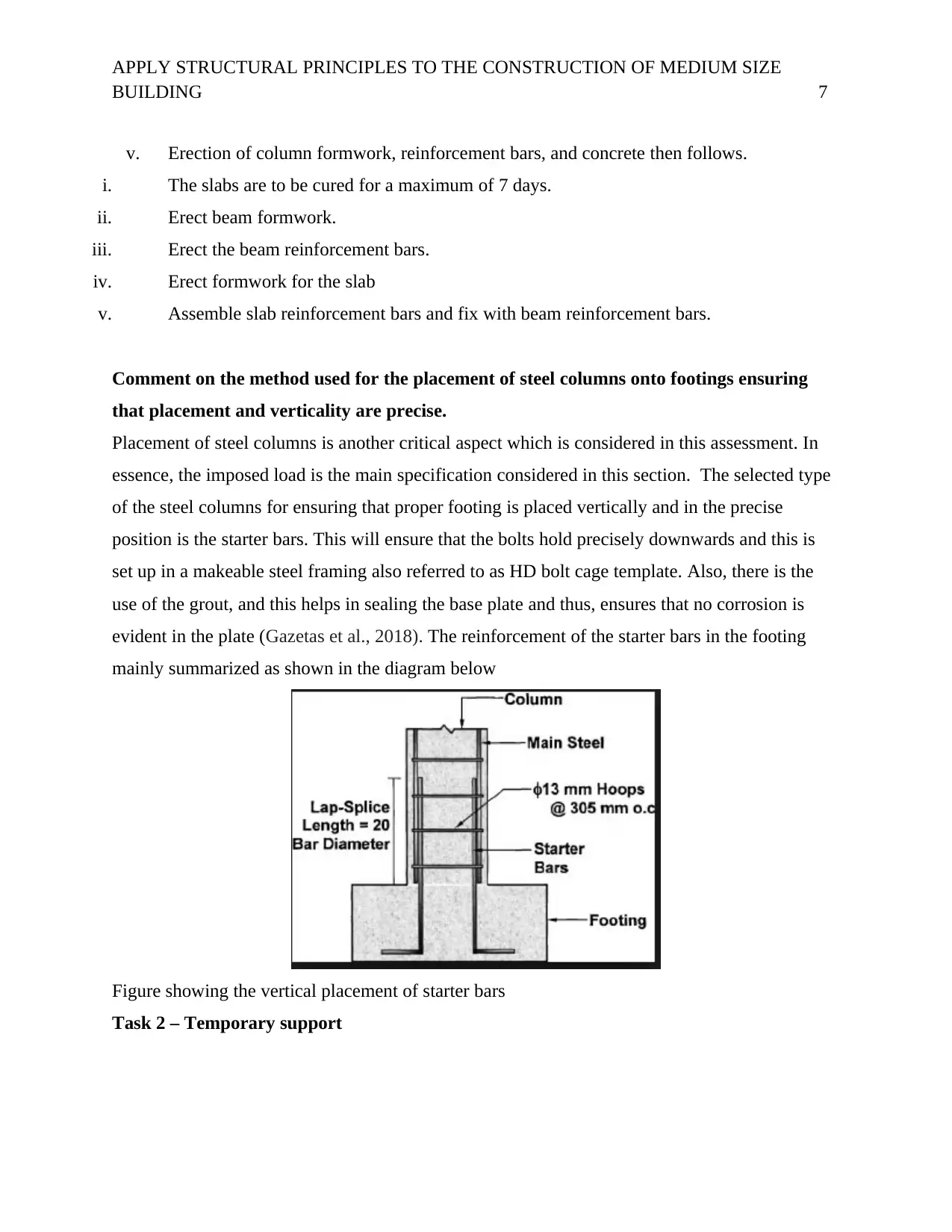
APPLY STRUCTURAL PRINCIPLES TO THE CONSTRUCTION OF MEDIUM SIZE
BUILDING 7
v. Erection of column formwork, reinforcement bars, and concrete then follows.
i. The slabs are to be cured for a maximum of 7 days.
ii. Erect beam formwork.
iii. Erect the beam reinforcement bars.
iv. Erect formwork for the slab
v. Assemble slab reinforcement bars and fix with beam reinforcement bars.
Comment on the method used for the placement of steel columns onto footings ensuring
that placement and verticality are precise.
Placement of steel columns is another critical aspect which is considered in this assessment. In
essence, the imposed load is the main specification considered in this section. The selected type
of the steel columns for ensuring that proper footing is placed vertically and in the precise
position is the starter bars. This will ensure that the bolts hold precisely downwards and this is
set up in a makeable steel framing also referred to as HD bolt cage template. Also, there is the
use of the grout, and this helps in sealing the base plate and thus, ensures that no corrosion is
evident in the plate (Gazetas et al., 2018). The reinforcement of the starter bars in the footing
mainly summarized as shown in the diagram below
Figure showing the vertical placement of starter bars
Task 2 – Temporary support
BUILDING 7
v. Erection of column formwork, reinforcement bars, and concrete then follows.
i. The slabs are to be cured for a maximum of 7 days.
ii. Erect beam formwork.
iii. Erect the beam reinforcement bars.
iv. Erect formwork for the slab
v. Assemble slab reinforcement bars and fix with beam reinforcement bars.
Comment on the method used for the placement of steel columns onto footings ensuring
that placement and verticality are precise.
Placement of steel columns is another critical aspect which is considered in this assessment. In
essence, the imposed load is the main specification considered in this section. The selected type
of the steel columns for ensuring that proper footing is placed vertically and in the precise
position is the starter bars. This will ensure that the bolts hold precisely downwards and this is
set up in a makeable steel framing also referred to as HD bolt cage template. Also, there is the
use of the grout, and this helps in sealing the base plate and thus, ensures that no corrosion is
evident in the plate (Gazetas et al., 2018). The reinforcement of the starter bars in the footing
mainly summarized as shown in the diagram below
Figure showing the vertical placement of starter bars
Task 2 – Temporary support
Paraphrase This Document
Need a fresh take? Get an instant paraphrase of this document with our AI Paraphraser
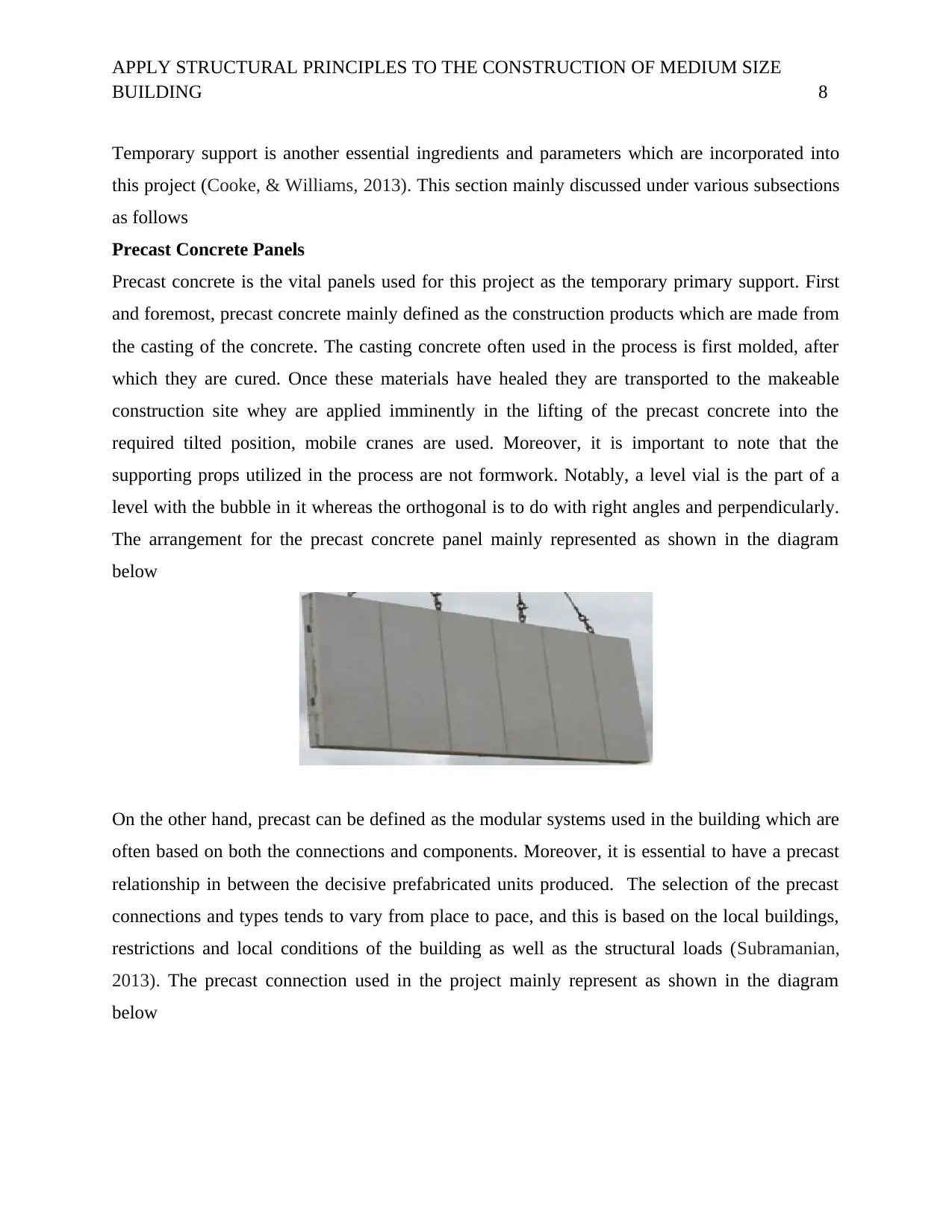
APPLY STRUCTURAL PRINCIPLES TO THE CONSTRUCTION OF MEDIUM SIZE
BUILDING 8
Temporary support is another essential ingredients and parameters which are incorporated into
this project (Cooke, & Williams, 2013). This section mainly discussed under various subsections
as follows
Precast Concrete Panels
Precast concrete is the vital panels used for this project as the temporary primary support. First
and foremost, precast concrete mainly defined as the construction products which are made from
the casting of the concrete. The casting concrete often used in the process is first molded, after
which they are cured. Once these materials have healed they are transported to the makeable
construction site whey are applied imminently in the lifting of the precast concrete into the
required tilted position, mobile cranes are used. Moreover, it is important to note that the
supporting props utilized in the process are not formwork. Notably, a level vial is the part of a
level with the bubble in it whereas the orthogonal is to do with right angles and perpendicularly.
The arrangement for the precast concrete panel mainly represented as shown in the diagram
below
On the other hand, precast can be defined as the modular systems used in the building which are
often based on both the connections and components. Moreover, it is essential to have a precast
relationship in between the decisive prefabricated units produced. The selection of the precast
connections and types tends to vary from place to pace, and this is based on the local buildings,
restrictions and local conditions of the building as well as the structural loads (Subramanian,
2013). The precast connection used in the project mainly represent as shown in the diagram
below
BUILDING 8
Temporary support is another essential ingredients and parameters which are incorporated into
this project (Cooke, & Williams, 2013). This section mainly discussed under various subsections
as follows
Precast Concrete Panels
Precast concrete is the vital panels used for this project as the temporary primary support. First
and foremost, precast concrete mainly defined as the construction products which are made from
the casting of the concrete. The casting concrete often used in the process is first molded, after
which they are cured. Once these materials have healed they are transported to the makeable
construction site whey are applied imminently in the lifting of the precast concrete into the
required tilted position, mobile cranes are used. Moreover, it is important to note that the
supporting props utilized in the process are not formwork. Notably, a level vial is the part of a
level with the bubble in it whereas the orthogonal is to do with right angles and perpendicularly.
The arrangement for the precast concrete panel mainly represented as shown in the diagram
below
On the other hand, precast can be defined as the modular systems used in the building which are
often based on both the connections and components. Moreover, it is essential to have a precast
relationship in between the decisive prefabricated units produced. The selection of the precast
connections and types tends to vary from place to pace, and this is based on the local buildings,
restrictions and local conditions of the building as well as the structural loads (Subramanian,
2013). The precast connection used in the project mainly represent as shown in the diagram
below
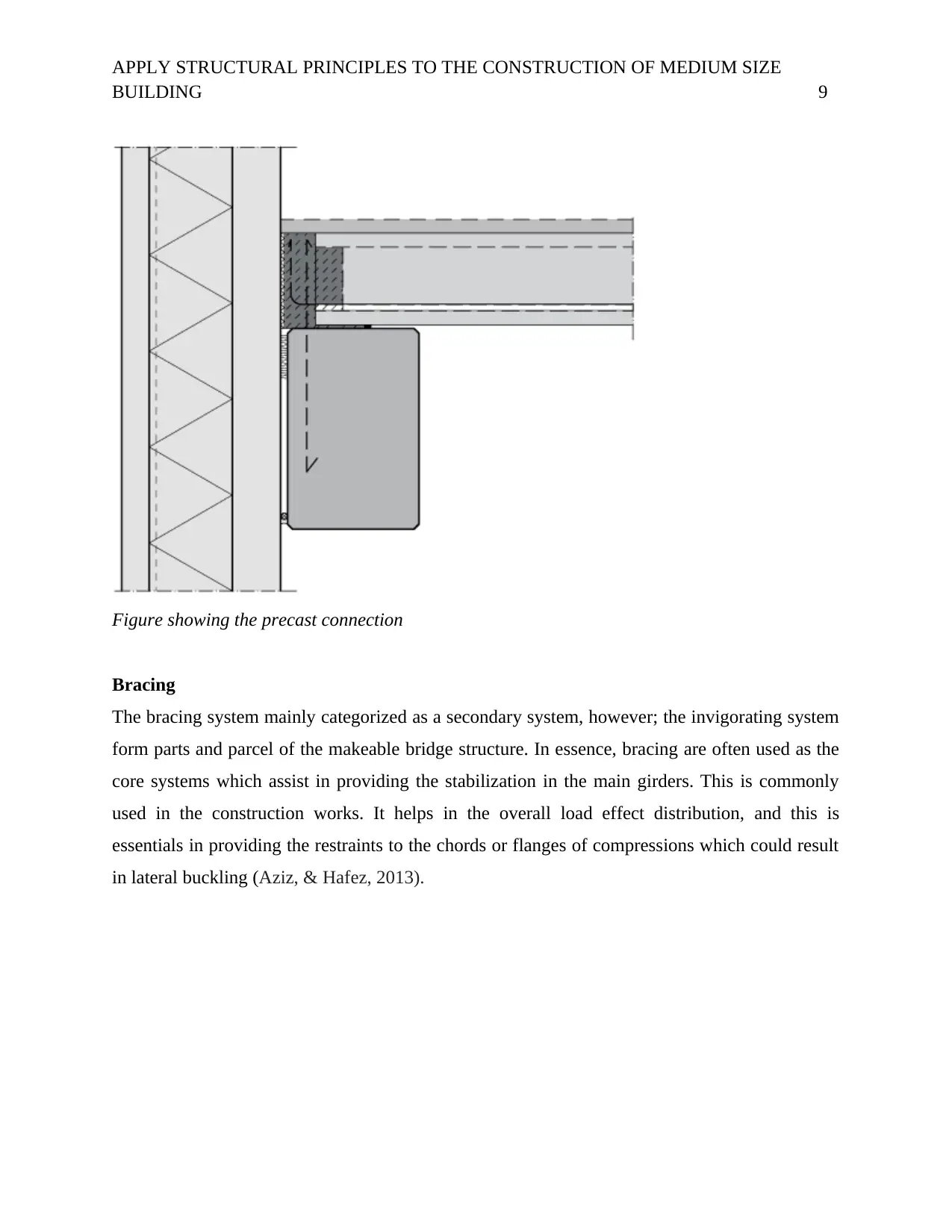
APPLY STRUCTURAL PRINCIPLES TO THE CONSTRUCTION OF MEDIUM SIZE
BUILDING 9
Figure showing the precast connection
Bracing
The bracing system mainly categorized as a secondary system, however; the invigorating system
form parts and parcel of the makeable bridge structure. In essence, bracing are often used as the
core systems which assist in providing the stabilization in the main girders. This is commonly
used in the construction works. It helps in the overall load effect distribution, and this is
essentials in providing the restraints to the chords or flanges of compressions which could result
in lateral buckling (Aziz, & Hafez, 2013).
BUILDING 9
Figure showing the precast connection
Bracing
The bracing system mainly categorized as a secondary system, however; the invigorating system
form parts and parcel of the makeable bridge structure. In essence, bracing are often used as the
core systems which assist in providing the stabilization in the main girders. This is commonly
used in the construction works. It helps in the overall load effect distribution, and this is
essentials in providing the restraints to the chords or flanges of compressions which could result
in lateral buckling (Aziz, & Hafez, 2013).
⊘ This is a preview!⊘
Do you want full access?
Subscribe today to unlock all pages.

Trusted by 1+ million students worldwide
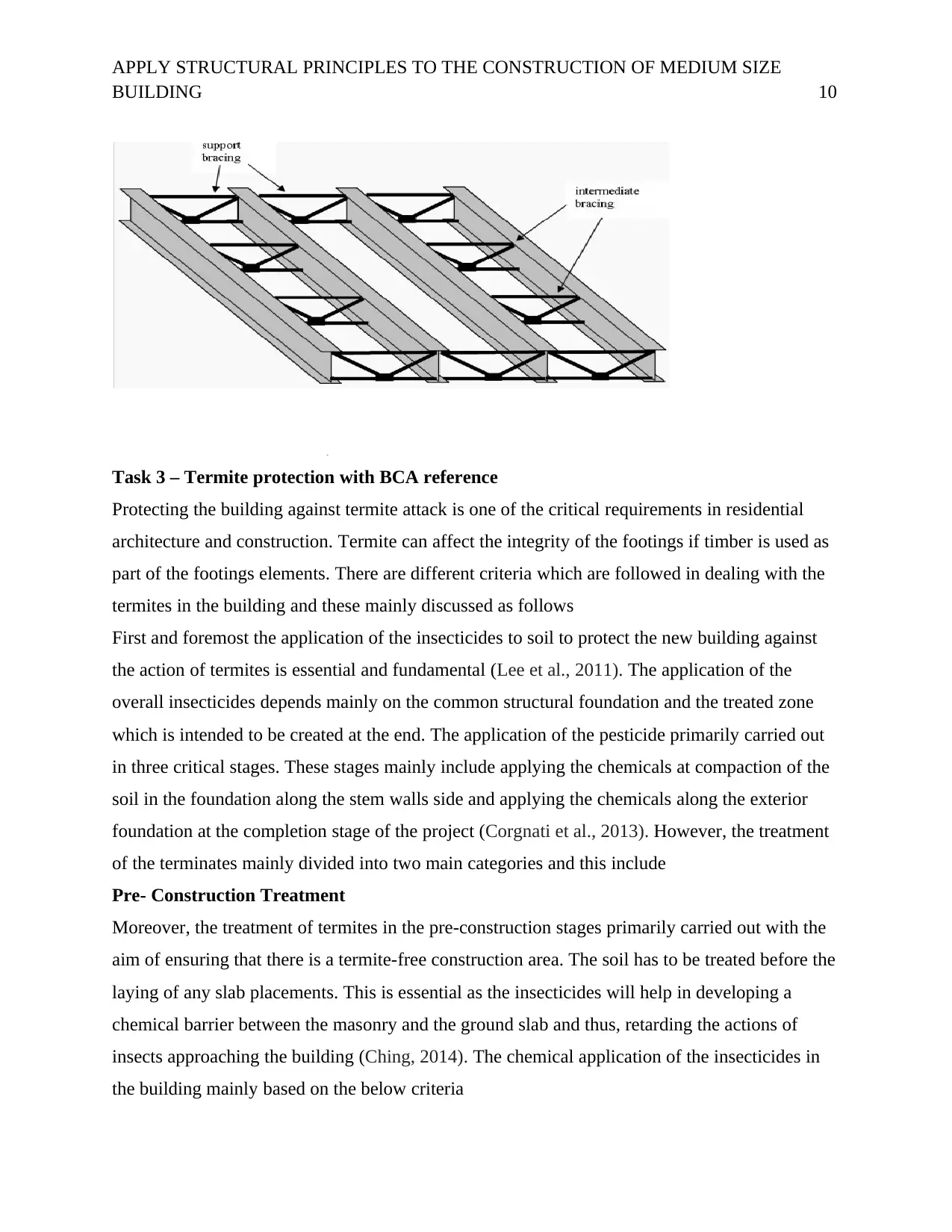
APPLY STRUCTURAL PRINCIPLES TO THE CONSTRUCTION OF MEDIUM SIZE
BUILDING 10
Task 3 – Termite protection with BCA reference
Protecting the building against termite attack is one of the critical requirements in residential
architecture and construction. Termite can affect the integrity of the footings if timber is used as
part of the footings elements. There are different criteria which are followed in dealing with the
termites in the building and these mainly discussed as follows
First and foremost the application of the insecticides to soil to protect the new building against
the action of termites is essential and fundamental (Lee et al., 2011). The application of the
overall insecticides depends mainly on the common structural foundation and the treated zone
which is intended to be created at the end. The application of the pesticide primarily carried out
in three critical stages. These stages mainly include applying the chemicals at compaction of the
soil in the foundation along the stem walls side and applying the chemicals along the exterior
foundation at the completion stage of the project (Corgnati et al., 2013). However, the treatment
of the terminates mainly divided into two main categories and this include
Pre- Construction Treatment
Moreover, the treatment of termites in the pre-construction stages primarily carried out with the
aim of ensuring that there is a termite-free construction area. The soil has to be treated before the
laying of any slab placements. This is essential as the insecticides will help in developing a
chemical barrier between the masonry and the ground slab and thus, retarding the actions of
insects approaching the building (Ching, 2014). The chemical application of the insecticides in
the building mainly based on the below criteria
BUILDING 10
Task 3 – Termite protection with BCA reference
Protecting the building against termite attack is one of the critical requirements in residential
architecture and construction. Termite can affect the integrity of the footings if timber is used as
part of the footings elements. There are different criteria which are followed in dealing with the
termites in the building and these mainly discussed as follows
First and foremost the application of the insecticides to soil to protect the new building against
the action of termites is essential and fundamental (Lee et al., 2011). The application of the
overall insecticides depends mainly on the common structural foundation and the treated zone
which is intended to be created at the end. The application of the pesticide primarily carried out
in three critical stages. These stages mainly include applying the chemicals at compaction of the
soil in the foundation along the stem walls side and applying the chemicals along the exterior
foundation at the completion stage of the project (Corgnati et al., 2013). However, the treatment
of the terminates mainly divided into two main categories and this include
Pre- Construction Treatment
Moreover, the treatment of termites in the pre-construction stages primarily carried out with the
aim of ensuring that there is a termite-free construction area. The soil has to be treated before the
laying of any slab placements. This is essential as the insecticides will help in developing a
chemical barrier between the masonry and the ground slab and thus, retarding the actions of
insects approaching the building (Ching, 2014). The chemical application of the insecticides in
the building mainly based on the below criteria
Paraphrase This Document
Need a fresh take? Get an instant paraphrase of this document with our AI Paraphraser

APPLY STRUCTURAL PRINCIPLES TO THE CONSTRUCTION OF MEDIUM SIZE
BUILDING 11
Both the sides and the bottom of the overall excavation need to be treated in a decisive
manner using the chemicals before laying the foundation.
All the holes from which the slab grades are intended to be constructed must be treated
with chemical products
Applying the chemical in all the floors, pipe beddings as well as in the walls is
recommended
Post-Construction Treatment
The termite protection in the post-construction is also another critical aspect which is taken into
consideration (Rust, 2014). The evaluation in this stage involves a number of activities which
include assessing the entire area, determining the damage extent, locating and identifying the
termite present as well as establishing the access points in line with the structure and the spread
area.
Safety Measures in Termite Protection in Construction
There are various safety measures which one need to consider and incorporate in the treatment of
termites in the building, and some of these considerations include
It is important to keep all the gutters as well as drains clean and in check as this will help
in avoiding any related leakage
Eliminating of all the moisture sources is also essential
Applying chemicals in any sections which have been detected to be affected by termites
Filling all the junctions and the voids in the building
BUILDING 11
Both the sides and the bottom of the overall excavation need to be treated in a decisive
manner using the chemicals before laying the foundation.
All the holes from which the slab grades are intended to be constructed must be treated
with chemical products
Applying the chemical in all the floors, pipe beddings as well as in the walls is
recommended
Post-Construction Treatment
The termite protection in the post-construction is also another critical aspect which is taken into
consideration (Rust, 2014). The evaluation in this stage involves a number of activities which
include assessing the entire area, determining the damage extent, locating and identifying the
termite present as well as establishing the access points in line with the structure and the spread
area.
Safety Measures in Termite Protection in Construction
There are various safety measures which one need to consider and incorporate in the treatment of
termites in the building, and some of these considerations include
It is important to keep all the gutters as well as drains clean and in check as this will help
in avoiding any related leakage
Eliminating of all the moisture sources is also essential
Applying chemicals in any sections which have been detected to be affected by termites
Filling all the junctions and the voids in the building
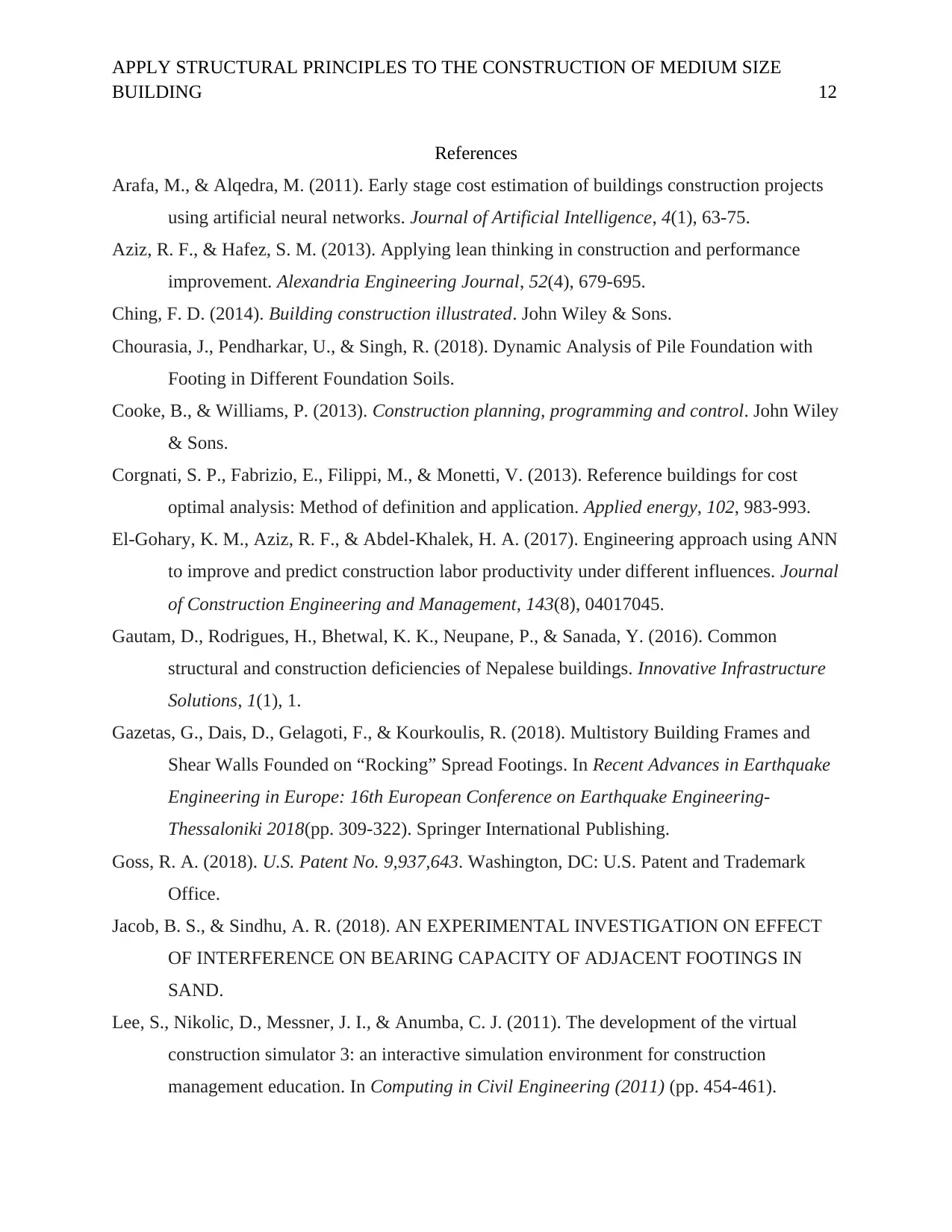
APPLY STRUCTURAL PRINCIPLES TO THE CONSTRUCTION OF MEDIUM SIZE
BUILDING 12
References
Arafa, M., & Alqedra, M. (2011). Early stage cost estimation of buildings construction projects
using artificial neural networks. Journal of Artificial Intelligence, 4(1), 63-75.
Aziz, R. F., & Hafez, S. M. (2013). Applying lean thinking in construction and performance
improvement. Alexandria Engineering Journal, 52(4), 679-695.
Ching, F. D. (2014). Building construction illustrated. John Wiley & Sons.
Chourasia, J., Pendharkar, U., & Singh, R. (2018). Dynamic Analysis of Pile Foundation with
Footing in Different Foundation Soils.
Cooke, B., & Williams, P. (2013). Construction planning, programming and control. John Wiley
& Sons.
Corgnati, S. P., Fabrizio, E., Filippi, M., & Monetti, V. (2013). Reference buildings for cost
optimal analysis: Method of definition and application. Applied energy, 102, 983-993.
El-Gohary, K. M., Aziz, R. F., & Abdel-Khalek, H. A. (2017). Engineering approach using ANN
to improve and predict construction labor productivity under different influences. Journal
of Construction Engineering and Management, 143(8), 04017045.
Gautam, D., Rodrigues, H., Bhetwal, K. K., Neupane, P., & Sanada, Y. (2016). Common
structural and construction deficiencies of Nepalese buildings. Innovative Infrastructure
Solutions, 1(1), 1.
Gazetas, G., Dais, D., Gelagoti, F., & Kourkoulis, R. (2018). Multistory Building Frames and
Shear Walls Founded on “Rocking” Spread Footings. In Recent Advances in Earthquake
Engineering in Europe: 16th European Conference on Earthquake Engineering-
Thessaloniki 2018(pp. 309-322). Springer International Publishing.
Goss, R. A. (2018). U.S. Patent No. 9,937,643. Washington, DC: U.S. Patent and Trademark
Office.
Jacob, B. S., & Sindhu, A. R. (2018). AN EXPERIMENTAL INVESTIGATION ON EFFECT
OF INTERFERENCE ON BEARING CAPACITY OF ADJACENT FOOTINGS IN
SAND.
Lee, S., Nikolic, D., Messner, J. I., & Anumba, C. J. (2011). The development of the virtual
construction simulator 3: an interactive simulation environment for construction
management education. In Computing in Civil Engineering (2011) (pp. 454-461).
BUILDING 12
References
Arafa, M., & Alqedra, M. (2011). Early stage cost estimation of buildings construction projects
using artificial neural networks. Journal of Artificial Intelligence, 4(1), 63-75.
Aziz, R. F., & Hafez, S. M. (2013). Applying lean thinking in construction and performance
improvement. Alexandria Engineering Journal, 52(4), 679-695.
Ching, F. D. (2014). Building construction illustrated. John Wiley & Sons.
Chourasia, J., Pendharkar, U., & Singh, R. (2018). Dynamic Analysis of Pile Foundation with
Footing in Different Foundation Soils.
Cooke, B., & Williams, P. (2013). Construction planning, programming and control. John Wiley
& Sons.
Corgnati, S. P., Fabrizio, E., Filippi, M., & Monetti, V. (2013). Reference buildings for cost
optimal analysis: Method of definition and application. Applied energy, 102, 983-993.
El-Gohary, K. M., Aziz, R. F., & Abdel-Khalek, H. A. (2017). Engineering approach using ANN
to improve and predict construction labor productivity under different influences. Journal
of Construction Engineering and Management, 143(8), 04017045.
Gautam, D., Rodrigues, H., Bhetwal, K. K., Neupane, P., & Sanada, Y. (2016). Common
structural and construction deficiencies of Nepalese buildings. Innovative Infrastructure
Solutions, 1(1), 1.
Gazetas, G., Dais, D., Gelagoti, F., & Kourkoulis, R. (2018). Multistory Building Frames and
Shear Walls Founded on “Rocking” Spread Footings. In Recent Advances in Earthquake
Engineering in Europe: 16th European Conference on Earthquake Engineering-
Thessaloniki 2018(pp. 309-322). Springer International Publishing.
Goss, R. A. (2018). U.S. Patent No. 9,937,643. Washington, DC: U.S. Patent and Trademark
Office.
Jacob, B. S., & Sindhu, A. R. (2018). AN EXPERIMENTAL INVESTIGATION ON EFFECT
OF INTERFERENCE ON BEARING CAPACITY OF ADJACENT FOOTINGS IN
SAND.
Lee, S., Nikolic, D., Messner, J. I., & Anumba, C. J. (2011). The development of the virtual
construction simulator 3: an interactive simulation environment for construction
management education. In Computing in Civil Engineering (2011) (pp. 454-461).
⊘ This is a preview!⊘
Do you want full access?
Subscribe today to unlock all pages.

Trusted by 1+ million students worldwide
1 out of 13
Related Documents
Your All-in-One AI-Powered Toolkit for Academic Success.
+13062052269
info@desklib.com
Available 24*7 on WhatsApp / Email
![[object Object]](/_next/static/media/star-bottom.7253800d.svg)
Unlock your academic potential
Copyright © 2020–2025 A2Z Services. All Rights Reserved. Developed and managed by ZUCOL.





